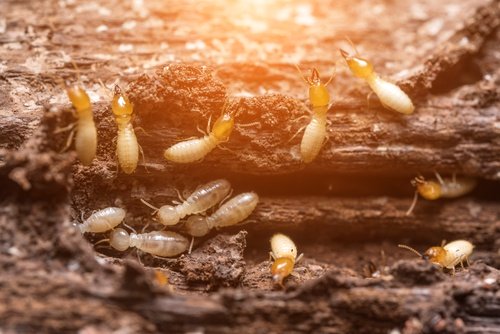Discovering that your home has been infested by termites can knock the wind out of you. These tiny little, hard to see pests can wreak havoc on your home. In fact, termites are considered to be the #1 threat to structures made out of wood—coming in ahead of flood, fire, and wind. Termites cause billions of dollars in damage in the US each year, which is excellent motivation to keep your home safe from them.
1. What do termites eat?
Termites love to munch on wood and other cellulose materials such as paper, cardboard, or even leaves. The difficult part is that they feed on wood from the inside out and underneath, so the wood appears normal even if it has been infested.
2. Do termites live alone or in groups?
A termite living alone won’t survive. Their lives are structured around living in colonies ranging in number from several thousand to millions. Like many types of insects, the social life of termite colonies include different roles such as the king and queen, who are responsible for reproduction, as well as worker termites and nymphs.
3. Can more than one colony infest a home?
In some places, several colonies of termites will occupy one area, but they don’t intermingle from one to the other.
4. What is the lifespan of a termite?
An individual termite of the worker variety can live approximately two years but a healthy termite colony will reproduce and live on for many years without intervention.
5. How fast can a termite eat wood?
Although one termite on its own may be very slow in eating, when multiplied by the thousands in a colony it’s much quicker. An average colony can eat approximately 2 feet of a 2×4 of wood in a year, which may not seem like a lot. However, they don’t take their meals in a neat and orderly fashion. Because they tunnel in and eat the wood from the inside out, termites can potentially damage the structural integrity of parts of your home within just a few months.
6. What attracts termites to homes?
Wood and other materials made from cellulose (such as firewood, lumber, cardboard and newspapers) act as a tasty meal to these destructive pests. If these materials are in the process of decaying, termites will be even more attracted as this is easier for them to eat.
7. Why do termites swarm?
Swarming termites develop during certain stages of the life cycle of a colony. With an appearance similar to flying ants, swarmers leave the current nest when it gets too big. This group of adults will move to a new area to begin another colony. When they are finished moving, swarmers tend to shed their wings and the appearance of these lying about may indicate a nearby nest.
See Also: Termites Swarming: Facts You Need to Know
8. Are termites active in Texas?
Termites love to live in warmer climates which makes Texas a favorite for them. Drywood and subterranean termites are the two most common types found in the state. Warm days after a rainfall are the most common times for termites to be on the move and swarming in Texas.
9. What are signs of termite infestation?
Wood damage from termites may be found behind surface walls and the underside of floors. A hollow sound when wood is tapped may also indicate damage. Early damage may look like cracks in the surface of wood or tunnels that resemble a maze. When termites swarm and move, they tend to discard their wings and these may be found near windows, doors, and other points of entry. In addition, an inspection of the ground outside an infested home may reveal mud tubes about the size of a pencil at places where the ground leads to trees, buildings, firewood piles, or other sources of food.
See Also: 3 Reasons Termites Can Go Undetected
10. How to prevent a termite infestation?
Clearing out as many potential food sources as possible should help with termite prevention. Store firewood at least 20 feet away from your home. Keep your gutters clear to avoid the collection of cellulose materials such as leaves or paper. Keep your home and property in good condition to prevent termite access through the roof, air conditioner unit, garage, or loose siding or other entry points.
When your home is being gnawed from the inside out, there’s no time to waste trying to learn do-it-yourself termite control. Instead, seek out a trusted pest control professional as soon as you suspect that you may have a termite problem. Even better, request a routine termite inspection to put your mind at ease even if you don’t see any signs yourself. For Houston pest control services that can help with termite control and other concerns, contact Cypress Creek.



